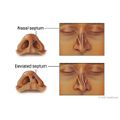Skip to main navigation
Skip to main content
Skip to footer
For
Medicare
For
Providers
For
Brokers
For
Employers
Español
For Individuals & Families:
For Individuals & Families
Medical
Dental
Other Supplemental
Explore coverage through work
How to Buy Health Insurance
Types of Dental Insurance
Open Enrollment vs. Special Enrollment
See all topics
Shop for Medicare plans
Member Guide
Find a Doctor
Log in to myCigna
Home
Knowledge Center
Wellness Library
Repair of a Deviated Septum (Septoplasty)
Repair of a Deviated Septum (Septoplasty)
Surgery Overview
The nasal septum is the wall between the nostrils that separates the two nasal passages. It supports the nose and directs airflow. The septum is made of thin bone in the back and cartilage in the front. A deviated septum means that the cartilage or bone isn't straight. A crooked septum can make it hard to breathe. It can also lead to snoring and sleep apnea.
The septum can bend to one side or the other as a part of normal growth during childhood and puberty. Also, the septum can be deviated at birth (congenital) or because of an injury, such as a broken nose. Very few people have a perfectly straight septum.
Before surgery, the doctor may use a thin, lighted tool (endoscope) to look at your nasal passages and to see the shape of your septum. In some cases, the endoscope may be used during surgery. You will receive local or general anesthesia for the 60- to 90-minute operation, which is usually done in an outpatient surgery center.
The septum and nasal passages are lined with a layer of soft tissue called the nasal mucosa. To repair the septum, the surgeon works through the nostrils, making an incision to separate the mucosa from the cartilage and bone. The doctor trims or straightens the bent cartilage and then replaces the mucosa over the cartilage and bone.
What To Expect After Surgery
What To Expect After Surgery
After surgery, you may have a nasal splint or pack placed in your nostrils to stop bleeding and keep the septum straight while it heals.
You probably will get instructions on how to care for your nose while it is healing. For example, you may be told not to blow your nose and to sneeze with your mouth open to avoid pressure changes.
How Well It Works
How Well It Works
This is a common nasal surgery, and most people recover well.
Risks
Risks
All surgery has a small risk of infection or bleeding. This surgery also carries a small risk of a hole (perforation) forming in the septum. A perforation rarely requires treatment. More surgery may be needed if the perforation causes discomfort or an infection develops.
Other risks include a small change in the shape of your nose or a continued blockage in your nose.
Current as of: October 27, 2024
Author: Ignite Healthwise, LLC Staff
Clinical Review Board
All Ignite Healthwise, LLC education is reviewed by a team that includes physicians, nurses, advanced practitioners, registered dieticians, and other healthcare professionals.
This information does not replace the advice of a doctor. Ignite Healthwise, LLC, disclaims any warranty or liability for your use of this information. Your use of this information means that you agree to the Terms of Use. Learn how we develop our content.
To learn more about Ignite Healthwise, LLC, visit webmdignite.com.
© 2024-2025 Ignite Healthwise, LLC.
Related Links
Sinusitis
Nose Injuries
<cipublic-spinner variant="large"><span>Loading…</span></cipublic-spinner>
